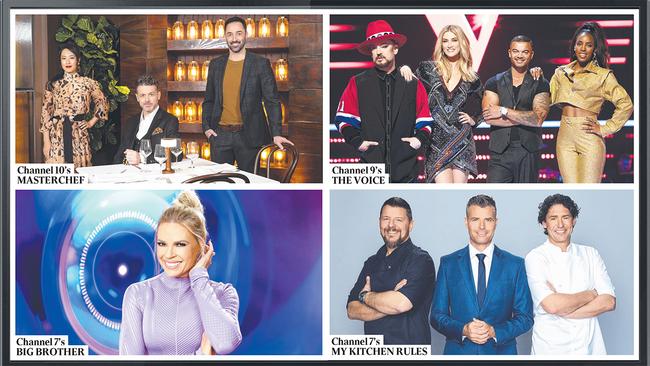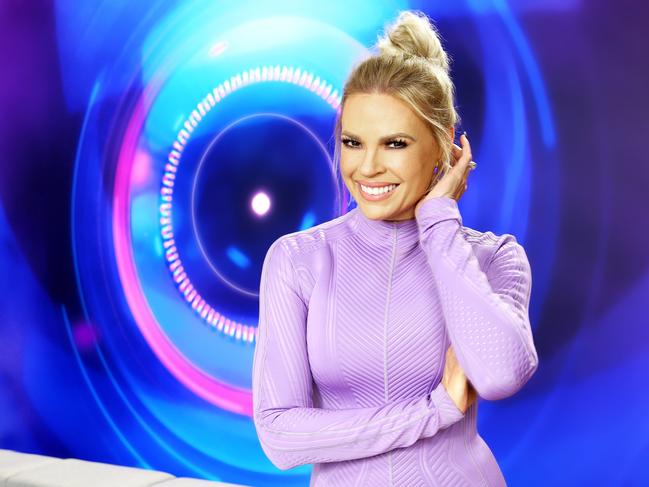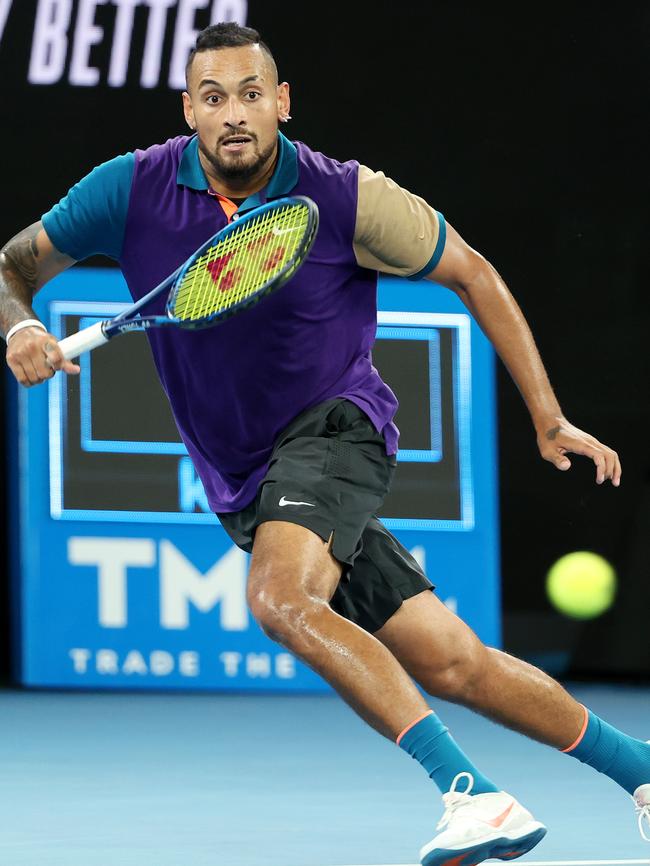Streaming and the big battle for the small screen
Free-to-air television is at the crossroads as streaming services make inroads into the lucrative under 55 age groups.

It’s been almost 65 years since Bruce Gyngell was beamed into living rooms across Australia with the historic, understated greeting: “Good evening, and welcome to television.”
It was a defining cultural moment for the nation, setting the scene for how Australians would see themselves, and the world, for decades to come. Television was exciting, and fresh, and – aside from the cumbersome box itself – it was free.
But in the digital age, and more specifically, in the era of subscription streaming, free-to-air television is fighting to survive.
According to a federal government-commissioned survey conducted last September by the Social Research Centre – and obtained by Inquirer – more than three-quarters of Australian households have at least one streaming subscription service.
But perhaps more telling is the neck-and-neck finding that 60 per cent of Australian adults reported that they had watched screen content on an online subscription service in the past seven days, while 61 per cent reported that they had watched commercial free-to air over the same period.
Steve Molk, co-creator and senior editor at industry website tvblackbox.com.au, says Australian free-to-air television is at the crossroads.
“The tipping point is now, right now,” he tells Inquirer.
“Streaming services are the dominant force, and the free-to-air networks are struggling to make any inroads with the under 55s.”
And if the inevitable looming market dominance of the streaming services isn’t troubling enough for television network executives, the demographic breakdown of the figures from the SRC survey offers a stark glimpse into their future.
Those aged 55 or older were considerably more likely to consume news via commercial free-to-air TV than the two younger age groups (those aged 18-34 and 35-54 years) and males, who were far more likely to use news websites or apps.
That’s a worrying trend, particularly for the commercial networks. On any given weeknight the 6pm news bulletins on Seven and Nine are almost always the two highest-rating shows, and therefore, the most attractive to advertisers. A fall in overall viewer numbers is one thing, but losing the 18-54s is a hammer blow for the free-to-air networks, as it is those eyeballs that are the most valuable from an advertiser’s perspective.
While the flagship news bulletins are still considered the commercial networks’ golden ticket, sports broadcasting and reality shows haven’t been far behind over the past decade. But like the news programs, ratings are also falling in those formats.
The free-to-air networks are struggling to counter the successful push into sports by the likes of subscription services Foxtel and Stan, and viewing figures suggest that many are tiring of many of the same old reality TV offerings. In recent years, ratings have been steadily declining for the one-time juggernauts MasterChef, The Voice and My Kitchen Rules, while the rebooted Big Brother on Seven also failed to return to its former glory.

“For years, Nine and Seven have put up so-called ‘tentpoles’ (sure-fire ratings blockbusters) to hold up their schedules, but that’s getting harder to do,” Molk says.
Media analyst Peter Cox agrees, and says he would be surprised if there were more than two traditional free-to-air television networks in five years’ time.
“The problem is that they are underperforming in the areas where they are hoping to keep themselves alive – news, sport, reality shows,” he says.
“The free-to-air networks can’t really afford to have high-cost programs on their schedule all-year round. There’s just not the returns there anymore, there are not enough viewers to make it worthwhile.”
But Greg Hywood, chairman of Free TV Australia, the peak commercial television industry group, says claims that the free-to-air television industry is on a death spiral are wildly misinformed.
“You can never ever forget that free-to-air TV has one significant advantage – it’s free,” says Hywood, who was chief executive of Fairfax Media for eight years.
“You need to remember that no real media platform has ever died. Newspapers haven’t died, radio hasn’t died, cinemas haven’t died, linear TV hasn’t died, even vinyl is still going … each platform adapts. They mightn’t be as big or as profitable as they once were but it’s extremely unusual for them to die.”
Hywood concedes that subscription streaming services have disrupted the market, but points to the innovation and flexibility of free-to-air television’s own streaming arm, BVOD (Broadcaster Video-On-Demand), as being an effective counterweight.
“The networks saw the disruption of streaming a long way back, and substantially changed their mix to a very heavy emphasis on news, sport and reality television,” he says.
“But also the catch-up services belonging to Seven, Nine and Ten (7Plus, 9Now, 10Play) are very considerable components of the business. They are growing very rapidly.
“While the likes of Google and Facebook made it tougher for broadcasting advertising, the shortfall has been substantially made up by the catch-up services which have served as another advertising platform for free-to-air.”
Longtime media executive David Leckie, who spent extended periods as chief executive at both Nine and Seven, says the free-to-air advertising revenue is “bouncing back, big-time”.
He said the industry was possibly caught off-guard a few years ago by the rise of the streaming giants, but the free-to-air industry is still well-placed to remain competitive.
“I think for a while there, we (the commercial television networks) were pretty slack in selling our product. But things are improving.”
Steve Crawley, the executive director of Fox Sports, says pay television in Australia endured the tag of industry “apprentice” for years, but the quality of its content, its on-air talent and the standard of production are now its standout assets.
“I think when you ask people to pay for something, and you’re competing against a product that’s delivered free, the mentality is different. It’s got to be something worth paying for,” says Crawley, who was head of sports at the Nine Network for more than a decade before shifting to Foxtel.
“I believe pay television went through an apprenticeship, it went through being the ‘new kids on the block’, but that’s in the past. That’s not the mentality anymore.”

Certainly, Foxtel’s bumper ratings for the recently-completed Test cricket series between Australia and India supports Crawley’s argument, while sports streaming service Kayo continues to aggressively pursue a greater slice of the lucrative AFL and NRL market.
Aside from news, sport and reality television, an ongoing sore point within the industry is the lack of regulation over the amount of Australian content on the subscription platforms.
Despite the considerable expense of locally-made productions, and falling viewer numbers, Hywood rejects the idea that there could be less Australian content on our free-to-air networks in the future.
“Local content regulation has always been part and parcel of what we do. It’s the heart and soul of free-to-air in some ways … we don’t want to walk away from it.”
At present, all commercial free-to-air television licensees are required to broadcast an annual minimum transmission quota of 55 per cent Australian programming between 6am and midnight, and to provide 1460 hours of Australian content per year on their multichannels.
But there are – as yet – no such regulations governing the subscription video-on-demand (SVOD) services like Netflix, Amazon Prime, and Disney+.
Last November, the federal government released a media reform green paper, in which it recognised the financial pressures faced by the free-to-air television industry, and also emphasised the need to offer more support for the ongoing production of Australian content.
Upon the release of the paper, Communications Minister Paul Fletcher said the Australian television broadcast industry was under “severe strain”.
“If we do nothing, revenue for free-to-air television broadcasters will continue to decline and there is a risk that some providers may collapse,” he said.
“The production and availability of Australian content will suffer as broadcasters face rising commercial pressures from declining advertising revenue and competition from other platforms.
“The variety and quality of Australian content will shrink, leaving audiences with access to fewer Australian voices and stories.”
This week, Fletcher reiterated his commitment to protect Australian content on our screens, by ensuring the subscription streaming services carry some of the cost.
“The rapid growth of SVOD services in Australia has provided Australians with plenty of compelling new content. But very little of that content is Australian: compared to free-to-air and subscription television, the Australian content offerings of the SVODs are presently pretty threadbare,” he told Inquirer.
“As part of our government’s Green Paper … we are proposing to require large SVODs operating in Australia to invest a proportion of their Australian revenues in Australian content.
“These proposals would reduce the regulatory imbalance between broadcasters and their internet-based competitors, and sustain the continued delivery of high-quality Australian content.”
Hywood admits free-to-air television is transitioning to a new phase of its existence, but maintains that the industry will remain viable if it can adapt to the changing market and remain attractive to advertisers.
“As long as you understand that you’re in a competitive environment, and you manage your business well, you can make the adjustment. That’s really what’s ahead of all media players,” he says. “But amid all the changes, television has maintained its capability for mass branding, so it’s still very much desired by advertisers.
“Successful TV always depends on quality programming and capacity to meet consumer demand, and I think free-to-air television in this country can still meet those needs.”
It is, though, not as straightforward as it was in Bruce Gyngell’s day. “It might be free TV, but it’s not a free kick anymore,” says Hywood.




To join the conversation, please log in. Don't have an account? Register
Join the conversation, you are commenting as Logout